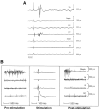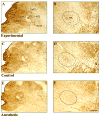Neuronal activation in the medulla oblongata during selective elicitation of the laryngeal adductor response
- PMID: 15212423
- PMCID: PMC2376830
- DOI: 10.1152/jn.00064.2004
Neuronal activation in the medulla oblongata during selective elicitation of the laryngeal adductor response
Abstract
Swallow and cough are complex motor patterns elicited by rapid and intense electrical stimulation of the internal branch of the superior laryngeal nerve (ISLN). The laryngeal adductor response (LAR) includes only a laryngeal response, is elicited by single stimuli to the ISLN, and is thought to represent the brain stem pathway involved in laryngospasm. To identify which regions in the medulla are activated during elicitation of the LAR alone, single electrical stimuli were presented once every 2 s to the ISLN. Two groups of five cats each were studied; an experimental group with unilateral ISLN stimulation at 0.5 Hz and a surgical control group. Three additional cats were studied to evaluate whether other oral, pharyngeal, or respiratory muscles were activated during ISLN stimulation eliciting LAR. We quantified < or = 22 sections for each of 14 structures in the medulla to determine if regions had increased Fos-like immunoreactive neurons in the experimental group. Significant increases (P < 0.0033) occurred with unilateral ISLN stimulation in the interstitial subnucleus, the ventrolateral subnucleus, the commissural subnucleus of the nucleus tractus solitarius, the lateral tegmental field of the reticular formation, the area postrema, and the nucleus ambiguus. Neither the dorsal motor nucleus of the vagus, usually active for swallow, nor the nucleus retroambiguus, retrofacial nucleus, and the lateral reticular nucleus, usually active for cough, were active with elicitation of the laryngeal adductor response alone. The results demonstrate that the laryngeal adductor pathway is contained within the broader pathways for cough and swallow in the medulla.
Figures






Similar articles
-
Role of the ventrolateral region of the nucleus of the tractus solitarius in processing respiratory afferent input from vagus and superior laryngeal nerves.Exp Brain Res. 1987;67(3):449-59. doi: 10.1007/BF00247278. Exp Brain Res. 1987. PMID: 3653307
-
Differential brainstem Fos-like immunoreactivity after laryngeal-induced coughing and its reduction by codeine.J Neurosci. 1997 Dec 1;17(23):9340-52. doi: 10.1523/JNEUROSCI.17-23-09340.1997. J Neurosci. 1997. PMID: 9364079 Free PMC article.
-
Projections of the internal branch of the superior laryngeal nerve of the cat.Brain Res Bull. 1986 May;16(5):713-21. doi: 10.1016/0361-9230(86)90143-7. Brain Res Bull. 1986. PMID: 3742253
-
Dorsal and ventral respiratory groups of neurons in the medulla of the rat.Brain Res. 1987 Sep 1;419(1-2):87-96. doi: 10.1016/0006-8993(87)90571-3. Brain Res. 1987. PMID: 3676744
-
Medullary mediation of the laryngeal adductor reflex: A possible role in sudden infant death syndrome.Respir Physiol Neurobiol. 2016 Jun;226:121-7. doi: 10.1016/j.resp.2016.01.002. Epub 2016 Jan 14. Respir Physiol Neurobiol. 2016. PMID: 26774498 Review.
Cited by
-
A mouse model of pharyngeal dysphagia in amyotrophic lateral sclerosis.Dysphagia. 2010 Jun;25(2):112-26. doi: 10.1007/s00455-009-9232-1. Epub 2009 Jun 3. Dysphagia. 2010. PMID: 19495873
-
Effects of aging and levodopa on the laryngeal adductor reflex in rats.Exp Gerontol. 2012 Dec;47(12):900-7. doi: 10.1016/j.exger.2012.07.008. Epub 2012 Jul 21. Exp Gerontol. 2012. PMID: 22824541 Free PMC article.
-
Central voice production and pathophysiology of spasmodic dysphonia.Laryngoscope. 2018 Jan;128(1):177-183. doi: 10.1002/lary.26655. Epub 2017 May 23. Laryngoscope. 2018. PMID: 28543038 Free PMC article. Review.
-
The blink reflex and its modulation - Part 1: Physiological mechanisms.Clin Neurophysiol. 2024 Apr;160:130-152. doi: 10.1016/j.clinph.2023.11.015. Epub 2023 Nov 30. Clin Neurophysiol. 2024. PMID: 38102022 Free PMC article. Review.
-
Distribution of Fos-Like Immunoreactivity, Catecholaminergic and Serotoninergic Neurons Activated by the Laryngeal Chemoreflex in the Medulla Oblongata of Rats.PLoS One. 2015 Jun 18;10(6):e0130822. doi: 10.1371/journal.pone.0130822. eCollection 2015. PLoS One. 2015. PMID: 26087133 Free PMC article.
References
-
- Abu-Shaweesh JM, Dreshaj IA, Haxhiu MA, Martin RJ. Central GABAergic mechanisms are involved in apnea induced by SLN stimulation in piglets. J Appl Physiol. 2001;90:1570–1576. - PubMed
-
- Altschuler SM, Bao XM, Bieger D, Hopkins DA, Miselis RR. Viscerotopic representation of the upper alimentary tract in the rat: sensory ganglia and nuclei of the solitary and spinal trigeminal tracts. J Comp Neurol. 1989;283:248–268. - PubMed
-
- Ambalavanar R, Ludlow CL, Wenthold RJ, Tanaka Y, Damirjian M, Petralia RS. Glutamate receptor subunits in the nucleus of the tractus solitarius and other regions of the medulla oblongata in the cat. J Comp Neurol. 1998;402:75–92. - PubMed
-
- Ambalavanar R, Purcell L, Miranda M, Evans F, Ludlow CL. Selective suppression of late laryngeal adductor responses by N-Methyl-D-Asparate receptor blockade in the cat. J Neurophysiol. 2002;87:1252–1262. - PubMed
-
- Ambalavanar R, Tanaka Y, Damirjian M, Ludlow CL. Laryngeal afferent stimulation enhances fos immunoreactivity in periaqueductal gray in the cat. J Comp Neurology. 1999;409:411–423. - PubMed
Publication types
MeSH terms
Substances
Grants and funding
LinkOut - more resources
Full Text Sources
Miscellaneous

